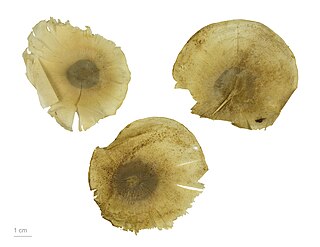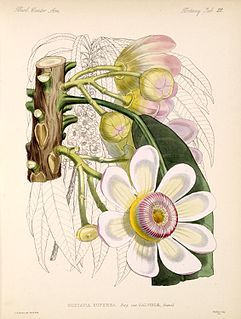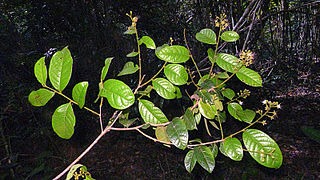Micrandra is a plant genus of the family Euphorbiaceae first described in 1854. It is native to South America.
Discocarpus is a genus of the plant family Phyllanthaceae first described as a genus in 1841. It is native to northern South America.
- Discocarpus essequeboensisKlotzsch - Brazil, Venezuela (Amazonas), Guyana, Suriname, French Guiana
- Discocarpus gentryiS.M.Hayden - S Venezuela (Amazonas), Peru (Loreto), N Brazil
- Discocarpus pedicellatusFiaschi & Cordeiro - State of Bahia in Brazil
- Discocarpus spruceanusMüll.Arg. - Venezuela (Amazonas), Brazil, Suriname (Sipaliwini), Bolivia

Couratari is a genus of trees in the family Lecythidaceae, first described as a genus in 1775. They are native to tropical South America and Central America.

Aspidosperma is a genus of flowering plant in the family Apocynaceae, first described as a genus in 1824. It is native to South America, Central America, southern Mexico, and the West Indies.

Navia is a genus of plants in the family Bromeliaceae, containing 95 species. Described as early as 1830 in Guyana, they are commonly cultivated for their colorful foliage and inflorescences. All the species are native to northern South America.

Lindmania is a genus of plants in the family Bromeliaceae. It is one of two genera in the subfamily Lindmanioideae, and contains 39 species. All but one of the known species are native to Venezuela, a few occurring in neighboring Guyana and northern Brazil).
Corythophora is a genus of woody plant in the Lecythidaceae family first described as a genus in 1939. It is native to northeastern South America.
- Corythophora altaR.Knuth - Pará, Amazonas
- Corythophora amapaensisPires ex S.A.Mori & Prance - French Guiana, Amapá
- Corythophora labriculata(Eyma) S.A.Mori & Prance - Suriname
- Corythophora rimosaW.A.Rodrigues - French Guiana, Amazonas, Amapá, Suriname

Micropholis is group of trees in the family Sapotaceae, described as a genus in 1891.

Gustavia is a genus of flowering plants in the family Lecythidaceae described by Linnaeus in 1775. It is native to tropical Central America and South America. Many of the species are threatened; some are critically endangered Gustavia superba, though, is actually abundant in re-growing secondary forests. It grows in northern South America, from Panama south through the Andes as far as Ecuador, and along the Caribbean coast and in the Amazon basin.

Hirtella is a genus of 110 species of woody trees in family Chrysobalanaceae. It was first described as a genus by Linnaeus in 1753. Hirtella naturally occurs in tropical forests throughout Latin America, the West Indies, southeast Africa, and Madagascar. The flowers are mainly pollinated by butterflies.

Monotagma is a genus of plant in family Marantaceae described as a genus in 1902. It is native to tropical America.

Couepia is a genus of flowering plants in the family Chrysobalanaceae described as a genus in 1775.
Streptostachys is a genus of South American plants in the grass family.
Thrasya is a genus of Neotropical plants in the grass family.
Froesiochloa is a genus of South American plants in the grass family. The only known species is Froesiochloa boutelouoides, native to Guyana, French Guiana, and Brazil.
Glossarion is a genus of South American flowering plants in the daisy family, Asteraceae.
Allantoma is a genus of woody plant in the family Lecythidaceae first described as a genus in 1874. It is native to northwestern South America (Colombia, Venezuela, Peru, northern Brazil.
- Allantoma decandra S.A.Mori, Ya Y.Huang & Prance - Peru, Brazil
- Allantoma integrifolia S.A.Mori - Amazonas State in Brazil
- Allantoma kuhlmannii S.A.Mori - Rondônia State in Brazil
- Allantoma lineata Miers - Amazonas State in Venezuela; Amazonas and Pará States in Brazil
- Allantoma pachyantha S.A.Mori, Ya Y.Huang & Prance - Amazonas State in Brazil
- Allantoma pauciramosa S.A.Mori, Ya Y.Huang & Prance - Amazonas State in Brazil
- Allantoma plurifloraS.A.Mori, Ya Y.Huang & Prance - Colombia
- Allantoma uaupensis S.A.Mori, Ya Y.Huang & Prance - Amazonas State in Brazil
Monotrema is a group of plants in the family Rapateaceae described as a genus in 1872.

Rapatea is a group of plants in the family Rapateaceae described as a genus in 1845.

Stegolepis is a group of plants in the family Rapateaceae described as a genus in 1872.










